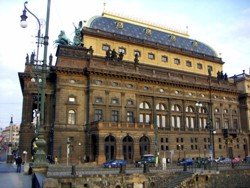
The fire of the National Theatre 125 years ago was a national tragedy
 |
"Weep, homeland! Cut off your face, Bohemia! The great National Theatre has burned down!" This is how the National Listy announced the devastating misfortune of the theatre, which turned to ashes just before its completion. The fire was accompanied by an unbelievable number of unfortunate accidents and strange circumstances. However, speculations may never be clarified.
Ironically, the security measures taken at the beginning of the catastrophe included the installation of the fashionable novelty of a lightning rod. It is said that the roofers, who finished work on August 12, poorly extinguished the charcoal in the soldering stove. They dumped the charcoal into the gutter and doused it with water. However, desultory glowing coals can remain in the charcoal if not extinguished properly, which, according to the investigation into the causes of the fire at that time, happened. The copper gutter heated up from the coals and caught the wooden covering of the roof on fire.
The fire was spotted around six in the evening. Firefighter Kořínek, during his rounds in the theatre, smelled smoke and saw flames above the stage in the rigging. The alarm in the building was triggered at 18:37. At the same time, a guard from Poštovská Street signaled. Therefore, at the fire station, they recorded only a line for the code ND in Morse alphabet, not recognizing where the fire was. Kořínek repeated the notification only half an hour later, and by then, it was already too late.
Among the first to fight the fire on the roof was sculptor Bohuslav Schnirch, whose Triggy still adorn the theatre today. However, the water stopped gushing after a few minutes. At the same time, the sprinkler system above the stage was activated, and all the hydrants in the building were opened, which reduced the water pressure and soon depleted its supplies. Moreover, the theatre was supplied by a waterworks in Karlova, where on the day before, the supply pipe had burst, significantly lowering the water level in the reservoir.
The iron curtain, under which scaffolding stood for the stucco artists, was ultimately lowered only partially; by then, the fire had already spread to the auditorium. The strong wind at that time also supported the spread of the fire. Residual gas in the pipes ignited as well. When the ceiling with the chandelier collapsed, it was the end. Fortunately, however, firefighters protected the surrounding buildings from the flames, particularly the neighboring Provisional Theatre. They managed to extinguish the fire only by six in the morning.
The fire completely destroyed the theatre's roof, stage, and auditorium, including decorations for the planned premiere of Libuše. The vestibule, foyer, loggias, and several rooms, such as the archive, dressing room, and theatre office, were preserved. The firefighters also saved many works of art. For the damage, the First Czech Mutual Insurance Company paid nearly 300,000 gold crowns.
In the heightened atmosphere after the tragedy, there were whispers about finding a culprit, with rumors suggesting that Prague Germans might have started the fire. At that time, clashes between Czechs and buršáks, members of nationalist German student organizations, who organized marches through the city and provoked, were frequent. Just at the end of June, during a skirmish in Chuchle, the Germans received a proper beating from the Prague residents. However, there was no evidence that it could have been their revenge.
The investigation focused on both craftsmen and determined that they had caused the fire through their negligence, though the court did not accept the defense's request for a practical examination. The crime of arson was not proven, and thus the locksmiths Emil Jenisch and Václav Zinniburg from the company Deckert and Homolka were only convicted of a misdemeanor and escaped with a mild sentence - a week in prison, compounded by two fasts and reimbursement of court costs. Among other reasons for the fire's devastating spread, the report from the Committee of the Fund for the Establishment of the National Theatre mentioned the poor functionality of the theatre's hydrants but also criticized the firefighters for their supposedly chaotic organization and insufficient equipment.
The suspicious number of coincidences surrounding the fire was attempted to be clarified by the non-fiction writer Miroslav Ivanov in his book. The expert examination conducted for him in 1982 at the Research and Testing Institute of Aviation showed that the building could not have ignited from the unextinguished embers. Thus, the convicted craftsmen were likely innocent.
The National Theatre was perhaps still burning, and funds for a new one were already being collected. Within four weeks, over a million gold crowns were raised, and within two years, the "golden chapel" stood again in all its glory, even improved with electric lighting. The restoration was completed by architect Josef Schulz. The author of the project, Josef Zítek, refused the reconstruction due to disputes with the Committee and never entered the National Theatre building again. The restored theatre was ceremonially opened on November 18, 1883.
The English translation is powered by AI tool. Switch to Czech to view the original text source.
2 comments
add comment
Subject
Author
Date
stručnost
lance
23.11.06 03:44
uza
neznami
28.10.09 07:08
show all comments
Related articles
0
27.11.2024 | The damage from the fire in the historic building of the National Theatre is preliminarily estimated at 10 million CZK
0
26.11.2024 | Dozens of firefighters responded to a fire in the historic building of the National Theatre
0
11.08.2021 | The destruction of the National Theatre by fire was aided by a number of coincidences
0
01.08.2014 | 105 years ago, the author of the National Theatre in Prague, Josef Zítek, passed away












